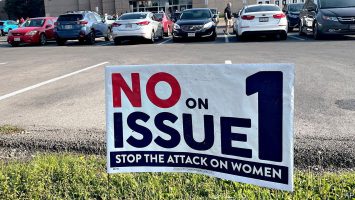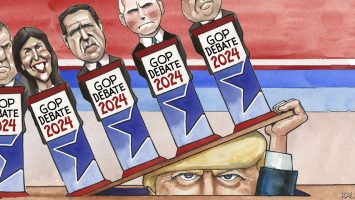
WHEN THE SUPREME COURT decided Bush v Gore a generation ago, five justices in effect handed George W. Bush the presidency over Al Gore. The implications of Trump v Anderson, which the court heard on February 8th, could be similarly momentous. But this time the justices are wary of making a splash in a presidential election and of splitting their votes along ideological lines. By the end of the oral argument, a consensus seemed to have emerged: despite his role in the events of January 6th 2021, Colorado will very probably not be allowed to remove Mr Trump from its ballot, nor will the other 49 states in this year’s election.
The historic hearing marked the first time the Supreme Court had considered the meaning and reach of Section 3 of the 14th Amendment, a provision that bars officials from holding future public office if, after taking an oath supporting the constitution, they engage in “insurrection or rebellion”. When rioters stormed the Capitol trying to overturn the 2020 election, scholars pointed to this relic of the Reconstruction era—a tool originally designed to keep former Confederate leaders away from the levers of power. Voters and advocacy groups in at least 35 states emerged to contend that Donald Trump is a modern-day insurrectionist who should be disqualified from a second presidential term.
Legal efforts stalled in most states, but on December 19th the Colorado Supreme Court cited Section 3 in ruling Mr Trump ineligible to appear on the ballot for the state’s Republican primary on March 5th. Defending that decision at the federal Supreme Court, Jason Murray (representing a group of voters including Norma Anderson, a 91-year-old Republican) called January 6th a “violent assault” that was “incited by a sitting president of the United States”.
This was one of few moments in two hours of wrangling that recalled the mayhem that transpired across the street from the Supreme Court three years ago. The hearing was dominated by bloodless parsing of legal technicalities and worries about what would happen if the Colorado court’s ruling stood.
In his opening pitch, Jonathan Mitchell, Mr Trump’s lawyer, did not say a word about January 6th. He did not deny that the riot was an “insurrection” (though he did, half-heartedly, later on). At no point did he offer a defence of his client’s behaviour. Instead, he said Section 3 does not apply to Mr Trump because a “president is not ‘an officer of the United States’ as that term is used throughout the constitution”. (An officer, he later explained, is a “term of art” applying “only to those who are appointed, not to those who are elected”.) Mr Mitchell also cast doubt on a state’s power to remove a presidential candidate from the ballot based on Section 3. The second sentence of that provision permits Congress to lift the ban by a two-thirds vote. So by prematurely removing a candidate from the ballot, a state is “accelerating the deadline to meet a constitutionally imposed qualification” and disenfranchising “potentially tens of millions of Americans”.
Justices from right to left voiced scepticism about entrusting states with the power to disqualify presidential aspirants. Justice Brett Kavanaugh made much of Griffin’s case, an 1869 circuit-court ruling that said Section 3 could not be applied unless Congress passed a law permitting the removal of insurrectionists. Justices Samuel Alito and Clarence Thomas noted that states have used Section 3 to disqualify candidates only for state, not federal, offices. The chief justice, John Roberts, looked to the purpose of the 14th Amendment: isn’t its “whole point”, he asked Mr Murray, ”to restrict state power”? Empowering states to disqualify candidates at will seems to be “at war” with that aim. If states cynically nix candidates from their ballots, elections could end up turning on just a “handful of states”. That, he warned, would be “a pretty daunting consequence”.
It was not only the six-justice conservative majority who were uncomfortable with Colorado’s erasing Mr Trump from the ballot. Justice Ketanji Brown Jackson eyed the list of offices Section 3 prohibits oath-breakers from holding and noticed that “president” and “vice-president” are not among them. Justice Elena Kagan amplified Chief Justice Roberts’s worries about the disarray that would follow from 50 states each having a say on who qualifies for the ballot. “Why should a single state”, she asked Mr Murray (who clerked for her a decade ago), “have the ability to make this determination not only for their own citizens but for the rest of the nation?”
Justice Sonia Sotomayor looks to be the only possible dissenting voice on a bench unwilling to approve a new regime of states making independent judgments about candidates’ fitness under Section 3. With primary season under way, the court is probably keen to allay confusion. The answer could come uncharacteristically swiftly for a court that normally takes months to rule: the justices are next scheduled to appear in the courtroom on February 16th.■
Stay on top of American politics with The US in brief, our daily newsletter with fast analysis of the most important electoral stories, and Checks and Balance, a weekly note from our Lexington columnist that examines the state of American democracy and the issues that matter to voters.



